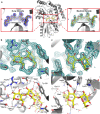Mapping periplasmic binding protein oligosaccharide recognition with neutron crystallography
- PMID: 36271099
- PMCID: PMC9587032
- DOI: 10.1038/s41598-022-20542-8
Mapping periplasmic binding protein oligosaccharide recognition with neutron crystallography
Abstract
Numerous studies have shown how periplasmic binding proteins (PBPs) bind substrates with exquisite specificity, even distinguishing between sugar epimers and anomers, or structurally similar ions. Yet, marked substrate promiscuity is also a feature encoded in some PBPs. Except for three sub-Ångström crystal structures, there are no reports of hydrogen atom positions in the remaining (> 1000) PBP structures. The previous X-ray crystal structure of the maltodextrin periplasmic-binding protein from Thermotoga maritima (tmMBP) complexed with oligosaccharide showed a large network of interconnected water molecules stretching from one end of the substrate binding pocket to the other. These water molecules are positioned to form multiple hydrogen bonds, as well as forming interactions between the protein and substrate. Here we present the neutron crystal structure of tmMBP to a resolution of 2.1 Å. This is the first neutron crystal structure from the PBP superfamily and here we unambiguously identify the nature and orientation of the hydrogen bonding and water-mediated interactions involved in stabilizing a tetrasaccharide in the binding site. More broadly, these results demonstrate the conserved intricate mechanisms that underlie substrate-specificity and affinity in PBPs.
© 2022. UT-Battelle, LLC.
Conflict of interest statement
The authors declare no competing interests.
Figures


References
Publication types
MeSH terms
Substances
LinkOut - more resources
Full Text Sources
Research Materials
Miscellaneous

